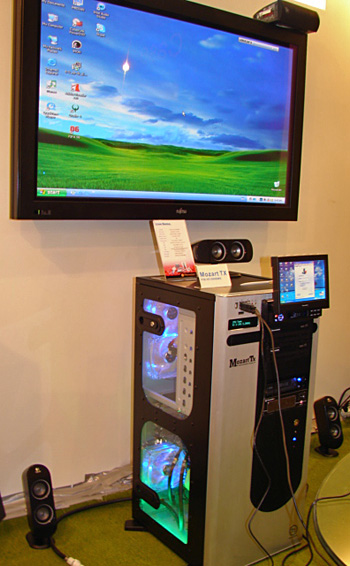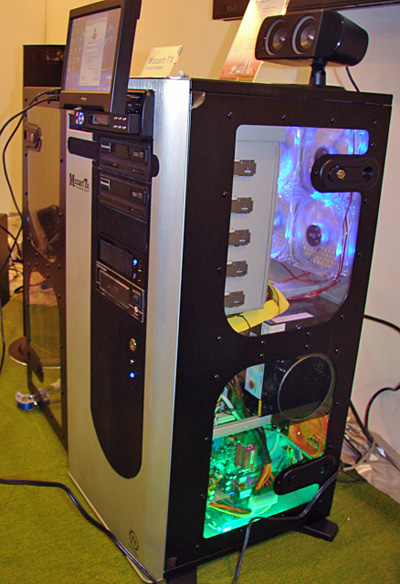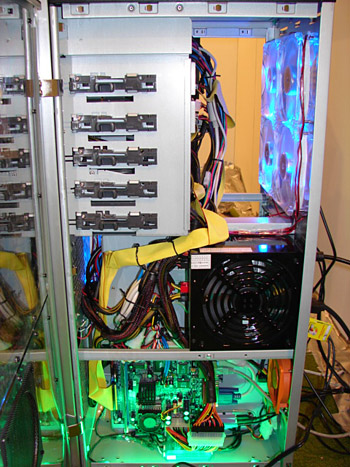Computex 2006: Abit is back, Biostar expands, and Thermaltake dazzles
by Gary Key on June 10, 2006 4:00 AM EST- Posted in
- Trade Shows

The amount of new products we witnessed in Thermaltake's display suites left us dizzy. Of course when we realized they employ close to 50 engineers in the Research and Design center the amount of new product introductions or revisions to existing product lines became understandable to us. We were welcomed with open arms by Annie Wu, Marketing Director; Weller Chen, OEM Product Marketing; and Jerry Lee, Marketing Assistant Manager. While we could spend the next ten pages or more describing all of the new products being launched by Thermaltake, we will spend time on a few products we thought were very interesting or out of the ordinary.
Thermaltake: Multimedia Products

Thermaltake is releasing the first cube tower designed to handle two separate PCs in a single chassis. The case is specifically designed to meet the growing Media PC market with an emphasis on providing a solution that allows you to install a high performance gaming or workstation system while still having the necessary room to install a system designed to work as a HTPC or media playback machine.

The case features the ability to handle a 7 inch Drive Bay with full support for a manual or retractable 7 inch LCD monitor (1280x768) that operates as a stand alone analog monitor. The case is fairly compact with measurements of 720mm x 330mm x 360mm (H/W/D). The depth measurement of 360mm is about 35% less than the typical 550mm depth of the average tower case.

The doors are easily removed and the right side of the case is sectioned off for the mini-ITX board. The case is designed to handle an ATX/micro-ATX, or Standard/Micro/Pico/Nano BTX motherboard on the left side with the right side being reserved for the mini-ITX boards. While we would have preferred micro-ATX capability for the secondary board, the good news is that several of the mini-ITX board designs we saw were sporting recent chipsets and processors that would not have an issue powering a basic HTPC configuration.

The left side of the case is sectioned off for a full size ATX or BTX capable motherboard. In this example, Thermaltake installed a BTX board and its unique cooling system. The case is actually sectioned off into four separate thermal areas with each section being totally independent of the others in the generation of airflow and removal of heat.










27 Comments
View All Comments
Operandi - Sunday, June 11, 2006 - link
Lian Li and SilverStone need companies like Thermaltake to make ugly ass cases to make theirs look good. ;)Griswold - Saturday, June 10, 2006 - link
Or the all-time classic:Optimus Prime called, he wants his chest armor back!
Lonyo - Saturday, June 10, 2006 - link
Putting passive cooling on their "max" motherboard. It makes me sad.vailr - Saturday, June 10, 2006 - link
Only one PCI slot on Abit's "Top of the Line" board? No thanks. Would need at least 2, or preferably 3 PCI slots.And regarding the passive/heatpipe chipset cooling: these won't work with some of
the Lian-Li mid-tower cases where the motherboard is oriented "upside-down".
Chernobyl68 - Saturday, June 10, 2006 - link
That was my first thought when I started seeing all of the passive cooling solutions out there...how would it work with the Lian-Li case I plan to buy? do I need to reconsider my options? I thought all I was waiting on was an acceptable motherboard to be released before I make my new system but I may be waiting a bit longer.Chern
Gary Key - Saturday, June 10, 2006 - link
We discussed this at length with Abit, too late to change now but we told them there would be a backlash. Also, if you run CrossFire or SLI, that single PCI slot is gone.
LoneWolf15 - Saturday, June 10, 2006 - link
Major case of "Aim gun at foot, pull trigger".
Unless Abit is willing to come up with some high quality PCIe peripherals to match, their high-end single-PCI slot boards are worthless, and releasing them will be a major monetary loss. With Crossfire/SLI, this means no Creative X-Fi (or insert other better-than-onboard-sound-card here), and limited choice of any other peripherals.
Universally stupid.
JarredWalton - Saturday, June 10, 2006 - link
The only major loss is sound card support, as you can currently get Theater 550 TV Tuners in PCIe format. I'm personally finding onboard audio sufficient for my needs, especially with the latest HDA solutions. X-Fi sounds better and cleaner, but it's not something you really notice unless you have really nice speakers/headphones.It's sort of like integrated NICs - is there anyone out there that really cares about the difference between 700 Mbit vs. 950 Mbit GbE performance? The only time I touch those speeds is when doing theoretical tests; HDD speeds are the limit otherwise, and gaming? Don't make me laugh: games don't even stress a 10 Mbit Ethernet connection in most instances, and certainly don't need more than 100 Mbit.
Anyway, my point is that integrated audio is fast nearing the point where few people worry about add-in sound cards. Get some digital speakers and use the S/PDIF connections on nice motherboards, and I'd love to see some people do a "blind" listening test. I'm sort of curious about what percentage of our readers still use add-in sound cards - I would be surprised if it's more than 10%.
Odeen - Tuesday, June 13, 2006 - link
There are a few problems with onboard audio. The sound quality is one of them. The second problem is the PERFORMANCE hit and the 3d sound rendering features available.Basically, onboard audio (and outboard audio processors without hardware DS3D and EAX support can emulate EAX, but not perfectly. EAX 4.0 is a no-go at all. And this emulation is tantamount to doing software 3D rendering - it's very slow, especially when dozens of sounds need to be located in 3D space and processed.
Any gamer owes it to himself to use a sound card capable of 3D sound processing, or they're cheating themselves out of frame rates.
BPB - Saturday, June 10, 2006 - link
Did they really think that people running Crossfire setups wouldn't at least want better-than-onboard sound? That alone is one PCI slot. The onboard sound looks good, but is it that good?